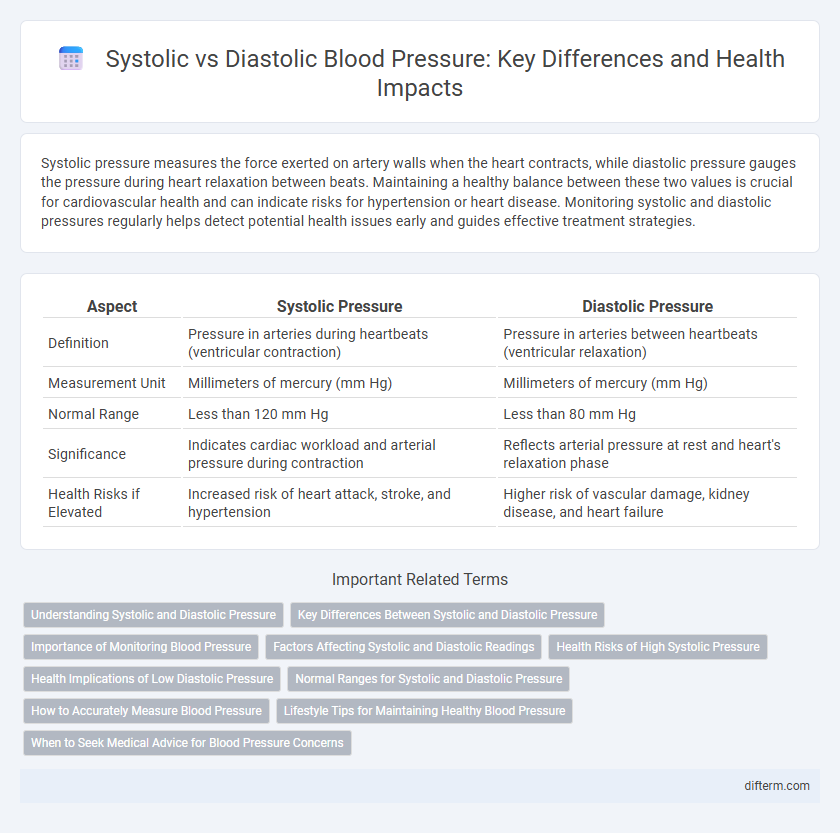Systolic pressure measures the force exerted on artery walls when the heart contracts, while diastolic pressure gauges the pressure during heart relaxation between beats. Maintaining a healthy balance between these two values is crucial for cardiovascular health and can indicate risks for hypertension or heart disease. Monitoring systolic and diastolic pressures regularly helps detect potential health issues early and guides effective treatment strategies.
Table of Comparison
| Aspect | Systolic Pressure | Diastolic Pressure |
|---|---|---|
| Definition | Pressure in arteries during heartbeats (ventricular contraction) | Pressure in arteries between heartbeats (ventricular relaxation) |
| Measurement Unit | Millimeters of mercury (mm Hg) | Millimeters of mercury (mm Hg) |
| Normal Range | Less than 120 mm Hg | Less than 80 mm Hg |
| Significance | Indicates cardiac workload and arterial pressure during contraction | Reflects arterial pressure at rest and heart's relaxation phase |
| Health Risks if Elevated | Increased risk of heart attack, stroke, and hypertension | Higher risk of vascular damage, kidney disease, and heart failure |
Understanding Systolic and Diastolic Pressure
Systolic pressure measures the force exerted on artery walls when the heart contracts, typically ranging between 90 and 120 mmHg in healthy adults. Diastolic pressure reflects the pressure in arteries when the heart rests between beats, usually between 60 and 80 mmHg. Accurate monitoring of both systolic and diastolic values is crucial for diagnosing hypertension and assessing cardiovascular risk.
Key Differences Between Systolic and Diastolic Pressure
Systolic pressure measures the force your heart exerts on artery walls during a heartbeat, represented as the higher number in a blood pressure reading, typically around 120 mmHg. Diastolic pressure indicates the pressure in the arteries when the heart rests between beats, usually the lower number, approximately 80 mmHg. The key differences lie in their measurement timing and clinical implications, with systolic pressure highlighting cardiac output and diastolic pressure reflecting arterial resistance.
Importance of Monitoring Blood Pressure
Monitoring systolic and diastolic blood pressure is crucial for detecting hypertension and preventing cardiovascular diseases. Systolic pressure measures the force exerted on artery walls during heartbeats, while diastolic pressure indicates pressure between beats, both providing essential data for assessing heart health. Consistent tracking allows early intervention, reducing risks of stroke, heart attack, and kidney damage.
Factors Affecting Systolic and Diastolic Readings
Systolic pressure is influenced by factors such as cardiac output, arterial stiffness, and physical activity, while diastolic pressure is affected by peripheral vascular resistance, blood vessel elasticity, and hormonal regulation. Age, stress, medications, and underlying health conditions like hypertension or diabetes can alter both systolic and diastolic readings. Monitoring variations in these pressures helps in assessing cardiovascular health and risk for conditions like stroke or heart attack.
Health Risks of High Systolic Pressure
High systolic pressure, the top number in a blood pressure reading, indicates increased force against artery walls during heartbeats, posing significant health risks such as heart attack, stroke, and kidney damage. Elevated systolic blood pressure is a primary risk factor for cardiovascular disease, often requiring lifestyle changes and medication to manage effectively. Monitoring and controlling systolic hypertension is crucial to reducing long-term complications related to vascular strain and organ damage.
Health Implications of Low Diastolic Pressure
Low diastolic pressure, typically below 60 mmHg, can lead to inadequate coronary artery perfusion, increasing the risk of heart ischemia and fatigue. Unlike systolic pressure, which measures arterial pressure during heartbeats, diastolic pressure reflects the resistance in blood vessels between beats, crucial for maintaining consistent organ perfusion. Persistent low diastolic readings may signal underlying conditions such as valve disorders or autonomic dysfunction, necessitating medical evaluation to prevent complications like dizziness, fainting, and organ damage.
Normal Ranges for Systolic and Diastolic Pressure
Normal systolic pressure typically ranges from 90 to 120 mmHg, while normal diastolic pressure ranges from 60 to 80 mmHg. These values indicate optimal blood pressure levels crucial for cardiovascular health, with systolic pressure reflecting the force exerted during heartbeats and diastolic pressure representing the pressure between beats. Maintaining blood pressure within these ranges reduces risks of hypertension-related complications such as stroke and heart disease.
How to Accurately Measure Blood Pressure
Accurately measuring blood pressure requires using a properly calibrated sphygmomanometer and placing the cuff at heart level on a relaxed arm. Systolic pressure, the higher value, reflects arterial pressure during heartbeats, while diastolic pressure, the lower value, indicates pressure between beats. Ensuring the patient is seated quietly for at least five minutes before measurement improves reliability of both systolic and diastolic readings.
Lifestyle Tips for Maintaining Healthy Blood Pressure
Maintaining healthy blood pressure involves balancing systolic pressure, the pressure during heartbeats, and diastolic pressure, the pressure between beats. Adopting a diet rich in fruits, vegetables, and low in sodium helps reduce systolic and diastolic readings effectively. Regular physical activity, stress management techniques, and maintaining a healthy weight are essential lifestyle choices for optimal blood pressure control.
When to Seek Medical Advice for Blood Pressure Concerns
Seek medical advice if systolic pressure consistently exceeds 140 mmHg or diastolic pressure rises above 90 mmHg, as these readings indicate hypertension risk. Immediate consultation is crucial if systolic pressure surpasses 180 mmHg or diastolic pressure exceeds 120 mmHg, signaling a hypertensive crisis requiring emergency care. Persistent symptoms like headaches, chest pain, or dizziness combined with high blood pressure also warrant prompt medical evaluation to prevent complications.
Systolic pressure vs Diastolic pressure Infographic

 difterm.com
difterm.com